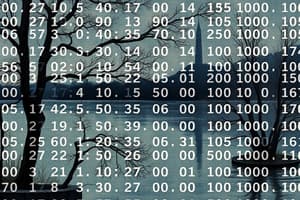Podcast
Questions and Answers
What is the primary reason why decimal numbers need to be converted to binary?
What is the primary reason why decimal numbers need to be converted to binary?
- Humans can only understand decimal numbers
- Binary numbers are easier to read
- Computers only understand binary language (correct)
- Decimal numbers are too complex
What is the first step in converting a decimal number to binary?
What is the first step in converting a decimal number to binary?
- Divide the decimal number by 2 (correct)
- Multiply the decimal number by 2
- Add 1 to the decimal number
- Subtract 1 from the decimal number
What is the purpose of taking the remainder and dividing it by 2 again in the decimal to binary conversion process?
What is the purpose of taking the remainder and dividing it by 2 again in the decimal to binary conversion process?
- To multiply the decimal number by 2
- To find the square root of the decimal number
- To find the decimal equivalent of the binary number
- To repeat the process until the result is 0 (correct)
What is the final step in converting a decimal number to binary using the division method?
What is the final step in converting a decimal number to binary using the division method?
What is the purpose of using a binary conversion table?
What is the purpose of using a binary conversion table?
What is the process of creating tiny computers and components less than 100 nanometers in size?
What is the process of creating tiny computers and components less than 100 nanometers in size?
What is the function of the Bus Interface Unit?
What is the function of the Bus Interface Unit?
What is the term for the series of operations involved in the execution of a single machine level instruction?
What is the term for the series of operations involved in the execution of a single machine level instruction?
What is the term for computers that use light to perform digital computations?
What is the term for computers that use light to perform digital computations?
What is the term for the ability to process one trillion floating-point operations per second?
What is the term for the ability to process one trillion floating-point operations per second?
Flashcards are hidden until you start studying
Study Notes
Decimal to Binary Conversion
Why Convert Decimal to Binary?
- Computers only understand binary language (0s and 1s)
- Decimal numbers are used by humans, but computers need binary to process information
Steps to Convert Decimal to Binary
- Divide the decimal number by 2
- If the result is a whole number, write down 0
- If the result is a decimal, write down 1
- Take the remainder and divide it by 2 again
- Repeat step 1 until the result is 0
- Read the binary digits from bottom to top
- The resulting sequence of 0s and 1s is the binary equivalent of the decimal number
Examples
- Convert 12 to binary:
- 12 ÷ 2 = 6 (0)
- 6 ÷ 2 = 3 (0)
- 3 ÷ 2 = 1.5 (1)
- 1 ÷ 2 = 0.5 (1)
- Binary equivalent: 1100
- Convert 25 to binary:
- 25 ÷ 2 = 12.5 (1)
- 12 ÷ 2 = 6 (0)
- 6 ÷ 2 = 3 (0)
- 3 ÷ 2 = 1.5 (1)
- 1 ÷ 2 = 0.5 (1)
- Binary equivalent: 11001
Shortcut: Using a Binary Conversion Table
- Create a table with powers of 2 (2^0, 2^1, 2^2, ...)
- Find the decimal number in the table and write down the corresponding binary digits
- Combine the binary digits to get the binary equivalent of the decimal number
Why Convert Decimal to Binary?
- Computers only understand binary language, consisting of 0s and 1s
- Decimal numbers are used by humans, but computers need binary to process information
Steps to Convert Decimal to Binary
- Divide the decimal number by 2, and write down 0 if the result is a whole number, or 1 if the result is a decimal
- Take the remainder and divide it by 2 again, repeating step 1 until the result is 0
- Read the binary digits from bottom to top to get the binary equivalent of the decimal number
Examples of Decimal to Binary Conversion
- 12 in decimal is equal to 1100 in binary
- 25 in decimal is equal to 11001 in binary
Shortcut: Using a Binary Conversion Table
- Create a table with powers of 2 (2^0, 2^1, 2^2,...)
- Find the decimal number in the table and write down the corresponding binary digits
- Combine the binary digits to get the binary equivalent of the decimal number
Studying That Suits You
Use AI to generate personalized quizzes and flashcards to suit your learning preferences.




